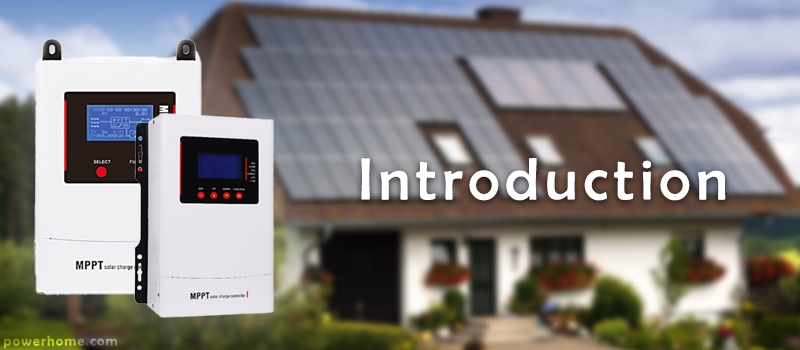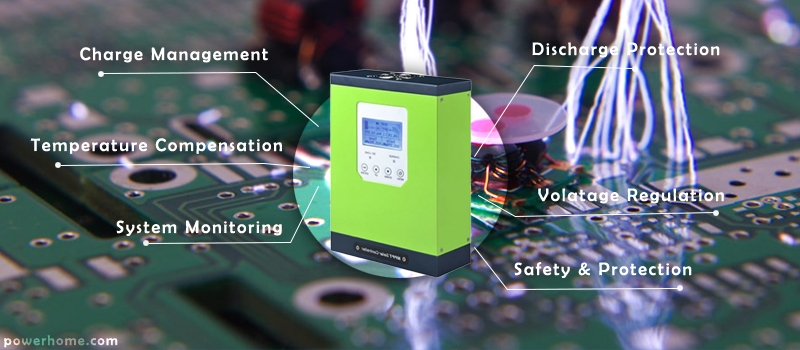Solar charge/discharge controllers are key components in PV systems, which improve the operational efficiency and stability of the whole system by precisely regulating the battery charge/discharge process. This blog will bring you a brief introduction to solar controllers, including types, functions and development prospects.
Introduction of Solar Charge Controller

Solar charge controller is the core element of the photovoltaic power generation system, which is responsible for regulating the charging of the solar panel to the battery and the discharging from the battery to the load, and at the same time protects the battery from over-charging and over-discharging damage. The controller's charge control and load control voltages are fully adjustable and can display battery voltage, load voltage, charge current and load current.
Through the precise management of the charging and discharging process, the solar charge controller can improve the energy utilization efficiency of the photovoltaic system, prolong the battery life and ensure the long-term stable operation of the system. Almost all solar power systems that utilize battery power are in extreme need of a solar charge/discharge controller.
There are two main types of solar charge regulators:
- PWM (Pulse Width Modulation) Controller: Control the charging current by adjusting the pulse width, simple structure, lower cost, suitable for cost-sensitive occasions.
- MPPT (Maximum Power Point Tracking) Controllers: Maximize the output power of the solar panel by adjusting the operating point in real time, higher efficiency, but also higher cost.
In other blogs, PowerHome will take you through these two charge controllers and their differences in detail.
Functions of Solar Charge Controller
The most basic function of the solar charge controller is to control the battery voltage and open up the circuit and stop the battery charging when the battery voltage rises to a certain level. Its functions also include:

-
Charge Management: Current generated by the PV panel will pass through the controller, which will regulate the current according to the state and needs of the battery in order to avoid overcharging the battery. Overcharging will damage the battery and shorten its service life.
-
Discharge Protection: When the voltage of the battery drops to a certain level, the controller will cut off the power supply of the load to prevent the battery from over-discharging. Over-discharge will also damage the battery and may even lead to irreversible damage.
-
Maximum Power Point Tracking (MPPT): Advanced controllers often have MPPT capabilities, meaning they are able to adjust the operating point of the solar panels in real time to maximize energy output. This is critical to improving the overall efficiency of the system.
-
Voltage Regulation: Solar controllers will ensure that the battery is charged within a safe and optimal operating voltage range, which helps to extend the life of the battery.
-
Temperature Compensation: Some controllers have a temperature compensation function that adjusts the charging voltage according to the ambient temperature in order to adapt to the charging characteristics of the battery at different temperatures.
-
System Monitoring: Modern solar charge regulators are usually equipped with displays or indicators that can show the system status, such as charging current, battery voltage, load status, etc., which is easy for users to monitor and maintain.
-
Safety and Protection Functions: The controller may also include functions such as overload protection, short circuit protection, reverse discharge protection, etc. to prevent the system from being damaged due to abnormal conditions.
Development Trend of Solar Charge Controller
Currently, solar controllers are developing towards multifunctionality, with a tendency to integrate the traditional control part, off-grid solar inverter, and monitoring system. Its development trend also includes:
-
Efficient Energy Management: As technology advances, charge controllers will more accurately achieve optimal management of energy and improve overall system efficiency.
-
Integrated Design: In the future, solar charge controllers may be integrated with other components (e.g. inverters, energy storage devices) to form an integrated solution and reduce system complexity.
-
Intelligent and Internet+: Making full use of IoT, big data and other technologies, solar controllers will be interconnected with other smart devices and sensors to realize information sharing and linkage control, in order to meet the needs of more intelligent application scenarios.
-
Standardization and Modularization: Promoting unified technical standards and modular design makes solar charge controllers easier to install, maintain and upgrade, and reduces overall project costs.
-
Personalized Customization: With the diversification of market demand, charge/discharge controllers will be developed towards personalized customization to meet the special needs of various application scenarios.
Solar charge/discharge controllers have a wide range of application prospects in the field of photovoltaic power generation systems, home solar applications, solar street lights and other fields. With the continuous innovation of technology, solar charge controllers will play a greater role in improving system performance, reducing costs, and promoting the sustainable development of solar power generation.
(1).png)
(1).png)